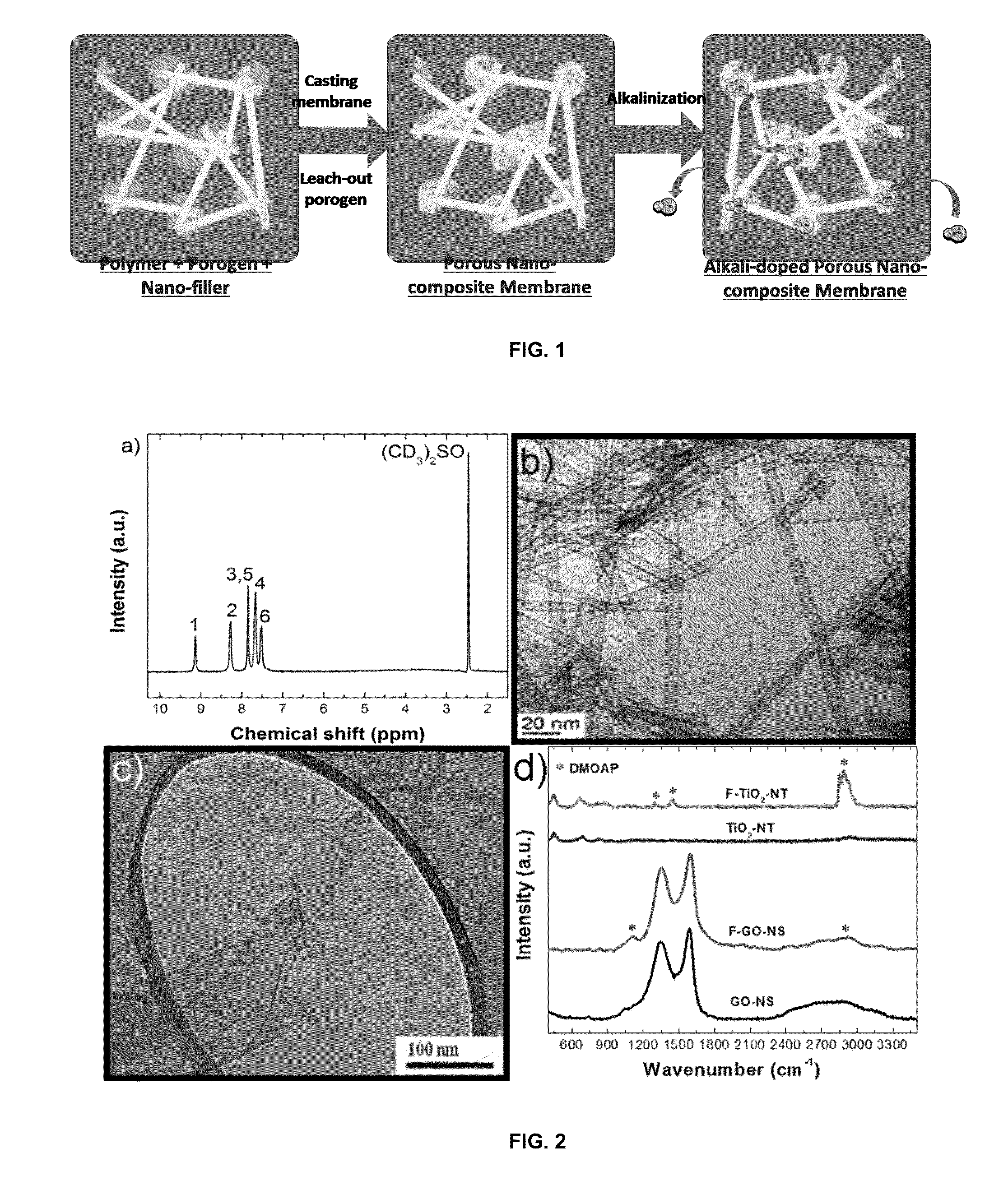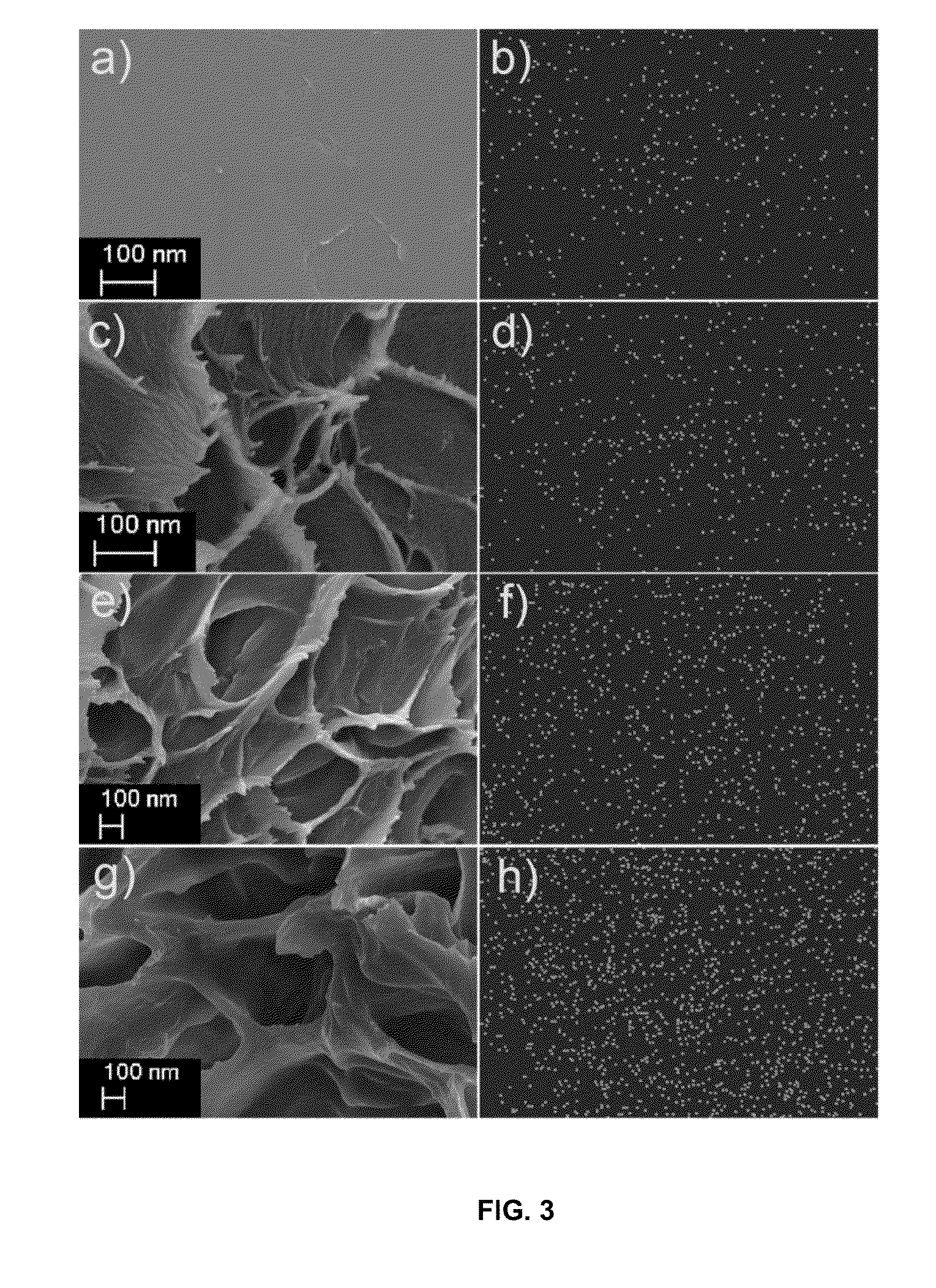Highly Ion-Conductive Nano-Engineered Porous Electrolytic Composite Membrane for Alkaline Electrochemical Energy Systems
a composite membrane, high-ion-conductive technology, applied in the field of membranes, can solve the problems of reducing the ion conductivity through the electrolyte, drying out quickly, and known membranes still lack high ionic-conductivity and durability, etc., to improve the physico-chemical stability and mechanical properties, increase the porosity, and improve the effect of ionic conductivity
- Summary
- Abstract
- Description
- Claims
- Application Information
AI Technical Summary
Benefits of technology
Problems solved by technology
Method used
Image
Examples
example 1
[0046]In this example, the PBI, TiO2-NTs, GO-NSs, and ammonium-functionalized nanomaterials, or nano-fillers, were produced. First, the PBI itself was synthesized. Equal amounts (in moles) of 3,3′-Diaminobenzidine (DAB) (Aldrich) and lsophthalic acid (IPA) (Aldrich) were dissolved in polyphosphoric acid (PPA) (Alfa Aesar) in a round-bottom flask. After stirring for 7 h at 200° C., the reaction mixture turned dark brown and became viscous. The reaction was quenched by pouring the hot solution into a large amount of cold water. The formed PBI fibers were stirred and washed for 48 h in water and 7 h in a 10% KOH solution, and then dried in an oven at 100° C. overnight. The successful synthesis of PBI was shown and confirmed by proton nuclear magnetic resonance spectroscopy (1H NMR, 500 MHz, Bruker Analytik GmbH), shown in FIG. 2a.
[0047]TiO2-NTs were prepared by the alkaline hydrothermal method. First, an appropriate amount of titania nanoparticle (TiO2-NP; 2-NT. The morphology of TiO2...
example 2
[0050]In this example the porous nano-composite PBI membranes were fabricated with different porosities and weight ratios of either non-functionalized or ammonium functionalized TiO2-NTs and GO-NSs. Appropriate amounts of the dried PBI polymer was dissolved in dimethyl sulfoxide (DMSO) under stirring and heating until an orange homogeneous solution was obtained. Then, the porogen DBP and the dispersed nanomaterials in DMSO were added. The uniform solution was spread onto a glass plate and placed in an oven at 60° C. for 2 days. After the formation of membrane, DBP was extracted by immersing the membranes in methanol for 1 h. The porous nano-composite PBIs were vacuum-dried at 50° C. until constant weight was achieved. Then, all membranes were doped and ion-exchanged with KOH by immersion in 6 M alkaline solution for 2 days and finally, stored in DDI water until future characterization tests. The cross-sectional images from SEM (LEO FESEM 1530) and EDX mapping of oxygen for the bare ...
example 3
[0051]The thermal stability and mechanical properties of porous nano-composite PBIs were estimated using thermogravimetric analysis (TGA, Q500 V20.10) and tensile machine (Admet eXpert™ 7603 series), respectively, as illustrated in FIGS. 4a and 4b. Generally, the increase of porosity has a slight effect on the thermal stability of the membrane. According to TGA-DTA curves, the initial weight loss below 200° C. can be attributed to the loss of unvaporized-bound water in PBI membranes, which changed from 2% to 5% by increasing the porosity from 0 wt. % to 70 wt. %. This indicated that because of the higher water affinity of porous PBI, more unvaporized-bound water existed in the membranes with higher porosity. From 200° C. to 500° C. the trend of weight change was almost close to a flat phase. The degradation temperature was started after 500° C. for all PBI membranes. Based on TGA-DTA curves, the increase of porosity from 0 wt. % to 70 wt. % caused the final weight loss to increase f...
PUM
| Property | Measurement | Unit |
|---|---|---|
| mean size | aaaaa | aaaaa |
| mean size | aaaaa | aaaaa |
| porosity | aaaaa | aaaaa |
Abstract
Description
Claims
Application Information
 Login to View More
Login to View More - R&D
- Intellectual Property
- Life Sciences
- Materials
- Tech Scout
- Unparalleled Data Quality
- Higher Quality Content
- 60% Fewer Hallucinations
Browse by: Latest US Patents, China's latest patents, Technical Efficacy Thesaurus, Application Domain, Technology Topic, Popular Technical Reports.
© 2025 PatSnap. All rights reserved.Legal|Privacy policy|Modern Slavery Act Transparency Statement|Sitemap|About US| Contact US: help@patsnap.com



